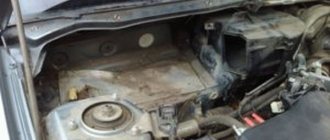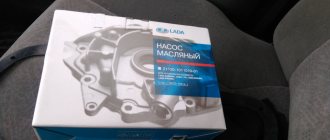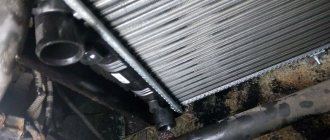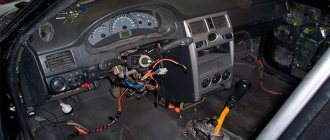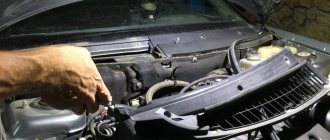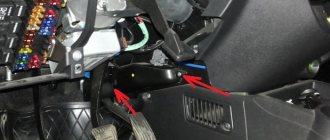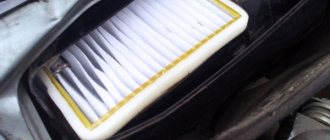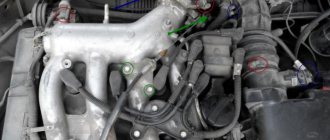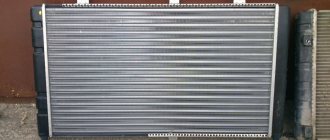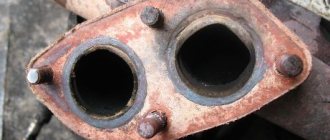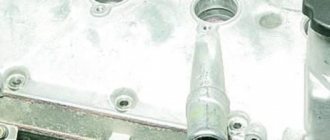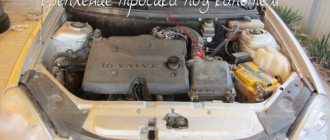Reason for the car owner's request LADA Priora At the service station there was an extraneous noise when the steering wheel moved. During diagnostics, a humming sound from the power steering pump was detected. Apparently the end of his work has come, or liquid power steering changed very rarely (recommended frequency 50-60 thousand km mileage). You can try to simply change the fluid to the original one or try to temporarily restore the pump, but it is better to replace it immediately power steering on Priora and don’t waste time. In addition, it is cheaper than buying fluid and a repair kit twice.
What kind of oil should I put in the Priora power steering?
What kind of oil to fill in power steering
It is not possible to fill the power steering with any oil. The difference between PSF and ATF is huge. The requirements for it are even greater than for the engine. It should be exclusively mineral water or synthetic, as well as a certain viscosity and propertiesRead more
From the factory, the Priora hydraulic booster is filled with light green oil Pentosin CHF 11S , the cost of which is more than 1,000 rubles per liter. Original article 00001-7504780-00-0 (price 1200 RUR). The manufacturer recommends using only original fluid for power steering , so the manual makes a note that using a fluid other than Pentosin Hydraulik Fluid CHF 11S-TL VW52137 may lead to malfunctions of the power steering pump!
We chose the synthetic gear oil “DEXRON III AUTOMATIC PLUS” from Mannol. Article number 1 liter bottle of power steering fluid - AP10107. The average market value is 390 rubles. It can also be liquid FEBI 6161 (price 500 rubles)
How much oil is in power steering Lada Priora
For a Priora with power steering, the expansion tank will require ~0.7 liters of fluid. When the system is completely pumped and flushed, the entire liter bottle can be used.
List of required tools
- Lift;
- 13 mm hex head ;
- The ratchet is large;
- Open-end wrench for 17, 22 and 27 mm ;
- Crosshead screwdriver;
- Sprocket T25 .
How to change the Priora power steering pump with your own hands (removal and replacement)?
- Unscrew the bolt securing the side protection - T25 ;
- Move the guard to the side;
- Loosen the drive belt roller nut using a 17 mm ;
- Raise the car;
- Remove the belt from the pulley;
- Remove the pulley - 13 mm ;
- Unscrew the pump fastenings - 13 mm ;
- Remove the clamp of the incoming oil pipe - a Phillips screwdriver;
- Pull out the pump;
- Remove the oil supply pipe fitting - a 22 and 27 mm ;
- Remove the power steering ;
- Compare with new pump;
- Install a new pump;
- Lower the car;
- Open the power steering reservoir cap;
- Fill in 0.5 power steering fluid;
- Pump liquid through the system;
- Top up until full ~ 0.2 liters ;
- Pump until liquid stops coming out.
Torque:
- Power steering pump mounting bolt - 30-40 Nm ;
- Power steering pulley bolts - 30-40 Nm ;
- Fitting nut - 60-70 Nm .
1
- DIY installation of power steering on a VAZ 2110
Using a T25 the bolt securing the side protection. We take her aside.
2
Find the drive belt tension roller nut. 17 mm spanner .
3
To gain access to the drive belt, lift the car.
4
Remove the drive belt from the power steering pulley.
5
The next step is to remove the power steering pulley. Unscrew the 3 nuts securing the pulley with a 13 mm .
- Life hack: power steering (power steering) of the Lada Priora, replacing the fluid, what it consists of
6
Remove the power steering pulley from its seat. The three power steering mounting bolts were opened. We unscrew them with a 13 mm .
7
There are three more bolts on the back of the power steering. We dismantle the fastenings.
8
Using a Phillips screwdriver, unscrew the clamp securing the inlet pipe.
9
Place a container or oil receiver under the power steering pump and drain the oil. In order for the power steering fluid to come out as much as possible, you need to manually turn the wheel left and right.
10
- How to install power steering on a VAZ 2107
22 mm open-end wrench and with a 27 mm .
11
Remove the power steering pump. We compare it with the new one to see if it matches.
12
We install a new pump, connect the oil supply and return pipes.
13
We lower the car and find the power steering reservoir under the hood. Remove the cover.
14
Fill the tank full. You will need ~ 0.5 liters of power steering oil.
15
We turn the wheel left and right without starting the car engine until air stops coming out of the power steering reservoir. Turn it all the way. We put on the drive belt. Then we start the engine and immediately turn it off. Add power steering fluid ~ 0.2 liters . We do not close the tank lid. We start the car engine and turn the steering wheel left and right (continue pumping) until the fluid stops escaping.
Driving a car used to be quite a difficult task. The power steering, also known as power steering, of the Lada Priora makes the steering wheel of the car light. The electric booster is even lighter, but not more informative. Priora has configurations with EUR and power steering. The amplifier operates using liquid, so in comparison with an electric amplifier, you need to monitor the level. On Priora, the assembled part will cost more than 7 thousand. The price is for the kit - it consists of 11 parts. Constantly being on the road tires you not only with emotional fatigue, but also with the incessant movement of the steering wheel, gear lever and pressing the pedals. To reduce the load on muscles, various systems are built into cars. Some of them make the pedals “lighter”, while others make it easier to turn the steering wheel.
The power steering for the Priora car has become a real salvation; the steering wheel has become lighter and more comfortable to use: to make a turn, you don’t need to use too much effort, tiring yourself. The power steering immediately picks up the force that the driver applies to the steering wheel and begins its work.
However, the mechanism requires attention: at certain moments it is necessary not to forget about replacing the Priora power steering fluid. Also, after a couple of years the hose cracks, so replacing the power steering hose in a Priora car is a matter of 3-6 years.
Questions discussed in the article
Power steering
Checking the steering system for leaks
Note
: It is necessary to check the tightness of the steering system after installation work and when there is no oil in the tank.
2. Turn the steering wheel in both directions until it stops and lock it briefly. As a result, maximum pressure is created in the system (only at idle speed).
3. In this position, it is necessary to check all pipeline connections for leaks.
Removing air from the power steering system
3. Turn the steering wheel in both directions until it stops until all air bubbles are removed from the fluid in the reservoir.
Note
: During pumping, add fluid to the tank so that its level does not fall below the filter level.
4. Make sure that the liquid is not milky and its level is at the “MAX” mark.
5. Make sure that the fluid level in the reservoir moves slightly when turning the steering wheel in both directions.
Note
: — If the liquid level shifts by more than 10 mm, repeat bleeding the system. — If the fluid level rises sharply when the engine is stopped, repeat bleeding the system — Incomplete removal of air causes rattling noise of the pump and increased noise of the distributor, in addition, it reduces the service life of the pump.
Replacing the working fluid
1. Lift the reservoir, then disconnect the return hose to drain the fluid. Do not spill liquid on the body or other parts. Wipe up any spilled liquid immediately.
2. Connect a tube of suitable diameter to the disconnected return hose and lower the end of the hose into a suitable container.
3. Raise the front of the car to hang the wheels off. Rotate the steering wheel from lock to lock until fluid stops flowing out of the tube.
4. Connect the return hose to the tank.
5. Fill the reservoir with power steering fluid and remove air from the power steering system.
Replacing pipes
Pipes between the power steering pump and the steering gear
For this operation you will need the following tools: 17 mm wrench, 22 mm wrench.
1. Open the hood and unscrew the fitting from the power steering pipe.
Note
: Close the openings of the pipe and pipeline with suitable plugs to prevent leakage of the power steering fluid.
2. Using two keys, loosen the tightening...
...and unscrew the power steering pipe fitting.
Note
: Close the openings of the pipes with suitable plugs to prevent leakage of the power steering fluid.
4. Using two wrenches, unscrew the locknut (1) of the pipe.
5. Disconnect the pipe from the bracket.
6. Unscrew the bolt and remove the pipe.
Note
: Close the hole in the power steering pump with a suitable plug to prevent leakage of working fluid and the ingress of foreign objects and contaminants.
7. Installation is carried out in the reverse order of removal.
8. Bleed the power steering system.
Pipe between the power steering pump and the expansion tank
For this operation you will need the following tools: screwdriver.
2. Using a screwdriver, loosen the clamp and disconnect the pipe from the expansion tank.
Note
: — Close the openings of the pipe and tank with suitable plugs. — Wipe up any spilled fluid.
4. Remove the engine splash guard.
5. Using a screwdriver, unscrew the bolt of the clamp securing the power steering pipe to the bracket on the generator.
6. Using a screwdriver, loosen the clamp and disconnect the pipe from the power steering pump.
Attention
: Care must be taken as working fluid will leak from the nozzle.
7. Installation is carried out in the reverse order of removal.
8. Add working fluid.
9. Carry out the procedure for removing air from the power steering system (see above).
Standard power steering (hydraulic booster) - article number and price
The standard power steering for the Priora received catalog number 21230340701200, the cost is from 7,500 rubles. Before ordering and purchasing, you should check the availability of fasteners. But the system itself is sold for spare parts:
- Long oil tank strap - 21100341010500 - about 500 rubles.
- Oil tank bracket - 21100341010000 - about 150 rubles.
- Power steering tank - 21230341001000 - about 900 rubles.
- Supply pipe - 21100340812500 - about 1,000 rubles.
- Power steering pump - 21100340700900 - about 6,000 rubles.
- Pillow – 21100340804000 – about 400 rubles.
- Low pressure pipe – 21100340804000 – about 400 rub.
- High pressure hose with tube – 2110034801810 – about 1,900 RUR.
- High pressure pipe – 21100340808001 – about 900 rub.
- Low pressure hose with tube – 21100340802600 – about 1,800 RUR.
- Front high pressure hose – 21100340810010 – about 1600 rub.
What does the power steering system consist of and how does it work?
The Priora's power steering works in the steering system. Its main part is the pump. The system fluid circulates in a special tank, pipes, and hoses that can withstand high pressure.
The operation of the hydraulic booster depends on the quality and “purity” of the corresponding working fluid in the system. When the driver turns the steering wheel, the pump increases the pressure of the working fluid, and it pushes the piston, increasing the force on the steering rack. In this case, the force that develops thanks to the pump is proportional to the resistance force that acts on the wheels - be it off-road or on a free track.
Main faults of the hydraulic booster on a Lada Priora car
When operating a Priora with power steering, the following problems may occur:
- When turning the steering wheel, a feedback is felt, similar to a push in the opposite direction (replacing or tightening the drive belt will help);
- It is difficult to turn the steering wheel (replacing or tightening the belt will help; adding fluid to the tank to the normal level, replacing or cleaning the filter; replacing the pump; removing the air lock or adjusting the idle speed);
- The steering is too “smooth” (adding fluid, removing the air lock and checking the steering, changing the tires will help);
- Extraneous noise during operation of the power steering (adding fluid, removing air lock or mechanical damage, checking the pump and replacing it will help);
- The steering wheel vibrates with weak shocks (removing the air lock in the system, balancing the wheels or changing the tires will help).
Priora steering rack malfunctions
Problems with the functioning of the steering rack can be different. To identify them, it is not necessary to have a wealth of special knowledge; it is enough to periodically inspect the mechanism.
Large steering play
If you turn off the engine and actively turn the steering wheel, there should be no extraneous sounds. When not only suspicious noises appear, but also play is observed, the cause of the problem may be a weakened spool stop or insufficient elasticity of the torsion bar. The steering wheel may play due to severe wear of the silent blocks on which the steering rack is fixed. The same problem occurs when the angle of contact between the teeth and the screw is incorrect, or the curvature of the crankcase or shaft is caused by damage or the stroke of a screw-type bearing. To determine the malfunction, you will need to diagnose the rack bushing, steering rod joints and teeth.
The appearance of knocking and heaviness when turning the steering wheel
The steering wheel becomes heavy due to a soured cardan, but most often it is the knocking that occurs. There are a number of characteristic reasons for this phenomenon:
- noise occurs during the movement of the vertical bearing shaft;
- excessive wear of joints and crankcase;
- exhaustion of the life of a screw bearing, bushing or teeth;
- crooked shaft or crankcase, as a result the screw contacts the teeth with an offset angle;
- wear of silent blocks;
- loose rack fastening;
- steering wheel play.
In any case, you will need to carry out diagnostics, and if malfunctions are identified, you will need to dismantle and repair the Priora steering rack with replacement of worn elements.
Worn steering shaft center tooth
Wear of the mechanism with teeth occurs quite often. The main purpose of the steering shaft is to convert rotational motion into translational motion. Most cars are characterized by the exhaustion of the resource of the central teeth. The reason is simple: movement in city traffic is determined by driving in a straight line with slight deviations of the trajectory to the left or right.
To determine the malfunction, you need to swing the steering wheel to the sides from the middle position. If knocking noises are heard, it is better to carry out further diagnostics at a service station. If the central tooth is worn excessively, the entire shaft must be replaced.
Repair: removal and installation of power steering Lada Priora
Replacement of Gur Priora and its repair must begin with correct diagnosis. It is also worth inspecting the reservoir of pipes and hoses in order to notice any damage in time. To remove the power steering you will need:
- stopper for retaining rings;
- key 12, head 14, 24;
- new bearing;
- syringe and container for draining liquid;
- fine-grained sandpaper and clean rags.
Working with power steering requires care - the system must remain sealed. The low pressure hose (2110 3408026 – article number) is often damaged. Therefore, the reason for the intrusion into the power steering system is the replacement of the Priora power steering hose. Repair work is carried out as follows:
- Park the car on level ground, tighten the handbrake, remove the negative from the battery.
- Find the hole in the pulley and unscrew the mounting bolt that secures the pump;
- Use a syringe to pump out the oil from the system. At the same time, rotate the steering wheel in different directions so that the liquid comes out of the hoses;
- Loosen the clamp attached to the reservoir hose. Take out the hose;
- Remove the bolt that secures the high pressure hose;
- Remove the bolt and replace it with a metal rod of the same diameter.
- Take out the pump, clean it of dirt, you can clean all the systems connected to it of dirt.
- If repair or replacement of the system is required, after repair, reassemble everything in the reverse order.
Prevention measures
To maximize the service life of the Priora steering rack, follow simple operating rules:
- bumps, potholes and speed bumps must be driven over at low speed and carefully;
- periodically inspect the condition of the anthers and seals;
- The oil in the power steering should be warmed up before driving (short turns by steering wheel);
- It is not recommended to frequently hold the steering wheel in the extreme right or left position.
By following these simple rules, you can avoid expensive repairs or replacement of the unit.
Replacing the power steering fluid of a Lada Priora car step by step instructions
To change the power steering fluid of the Priora, it is highly recommended to call a friend and partner. You will have to perform several operations simultaneously. For convenience, it is recommended to place the car in a pit or raise the front of the car on two supports using a jack. Prepare a container to drain the used fluid. Carry out work on replacing the Priora power steering fluid in the following order:
- Secure the car.
- Remove the power steering reservoir cap. Place the syringe into the tank and gradually pump out the liquid accumulated in it. For convenience, before putting the syringe into the tank, it is recommended to put a small hose on it. It is also recommended to cover with a cloth the entire engine compartment over which you will carry the syringe with oil to the container, so as not to pour in excess drops.
- Ask your partner to get into the car and turn the steering wheel. At this time, suck out the liquid that flows into the tank from the hoses.
- But that is not all. To collect the remaining oil, loosen the clamp of the high pressure hose, grab the hose, and lower it into the drain container.
- Ask your partner to turn the steering wheel again.
- Reinstall the hose and tighten the clamp tightly.
- Have someone start the engine for 10-20 seconds and then turn it off. After this, you need to turn the steering wheel again. During this time, the remaining air will leave the system.
- Add oil to the normal level. Screw on the tank cap and close the hood.
- Start the engine. Check if the power steering works as well as it did before.
Driving a car used to be quite a difficult task. The power steering, also known as power steering, of the Lada Priora makes the steering wheel of the car light. The electric booster is even lighter, but not more informative. Priora has configurations with EUR and power steering. The amplifier operates using liquid, so in comparison with an electric amplifier, you need to monitor the level. On Priora, the assembled part will cost more than 7 thousand. The price is for the kit - it consists of 11 parts. Constantly being on the road tires you not only with emotional fatigue, but also with the incessant movement of the steering wheel, gear lever and pressing the pedals. To reduce the load on muscles, various systems are built into cars. Some of them make the pedals “lighter”, while others make it easier to turn the steering wheel.
The power steering for the Priora car has become a real salvation; the steering wheel has become lighter and more comfortable to use: to make a turn, you don’t need to use too much effort, tiring yourself. The power steering immediately picks up the force that the driver applies to the steering wheel and begins its work.
However, the mechanism requires attention: at certain moments it is necessary not to forget about replacing the Priora power steering fluid. Also, after a couple of years the hose cracks, so replacing the power steering hose in a Priora car is a matter of 3-6 years.
Electric amplifier breakdowns
To diagnose a malfunction of the electric amplifier, you first need to determine the conditions under which the problem arose. There may be several of them:
- the failure occurred after discharging and then charging the battery;
- after turning the steering wheel at a large angle;
- when performing a parking maneuver;
- when driving at speeds above 110 km/h.
Based on these reasons, we can draw a conclusion about the nature of the occurrence of malfunctions. Often the cause of malfunction is low voltage of the on-board network. For normal operation of the EUR, the voltage must be at least 13.5 V. First, the battery is checked. If it is working, it is possible that the on-board network was de-energized after the battery was removed for recharging. To resume work, sometimes it is enough to turn the steering wheel 5-6 times to the extreme positions and back.
If everything is fine with the battery, you need to check the insulation of the wiring and connections for short circuits. The EUR on the Priora does not work in constant mode, like the power steering. The maximum load on the electric motor occurs when the steering wheel rotates at low speed or the car is stationary; the minimum load occurs when driving at speeds over 100 km/h. After reaching 110 km/h, the electric booster does not work at all.
If you hear knocking or other suspicious sounds while driving when turning the steering wheel, the fastening nut may have become loose - it needs to be lubricated and tightened. To do this, you need to dismantle the apron under the steering wheel and remove the casing. Sometimes a situation may arise when the wheels turn spontaneously. This directly indicates a malfunction of the electric power steering control unit.
The main problem with the EUR Lada Priora is that in order to reduce the cost of the design, a high-quality German-made electrical circuit was replaced with a domestic analogue, modified, but “crude”.
If the amplifier and speedometer do not work, then the problem is in the speed sensor - it is either dirty or faulty. The same goes for torque and steering angle sensors. First you need to clean them and reset errors from the on-board computer; for this you can use several methods:
- remove the terminal from the battery, de-energizing the on-board network;
- using diagnostic programs and an adapter for connecting to the OBD II diagnostic connector.
If you suspect that a fuse has blown, it should be checked and replaced if necessary. It is located in the mounting block, in the cabin, below the steering wheel on the left side. If any of the listed malfunctions occur, you can fix them yourself, but to completely replace the electric power steering mechanism, it is better to contact specialists.
Standard power steering (hydraulic booster) - article number and price
The standard power steering for the Priora received catalog number 21230340701200, the cost is from 7,500 rubles. Before ordering and purchasing, you should check the availability of fasteners. But the system itself is sold for spare parts:
- Long oil tank strap - 21100341010500 - about 500 rubles.
- Oil tank bracket - 21100341010000 - about 150 rubles.
- Power steering tank - 21230341001000 - about 900 rubles.
- Supply pipe - 21100340812500 - about 1,000 rubles.
- Power steering pump - 21100340700900 - about 6,000 rubles.
- Pillow – 21100340804000 – about 400 rubles.
- Low pressure pipe – 21100340804000 – about 400 rub.
- High pressure hose with tube – 2110034801810 – about 1,900 RUR.
- High pressure pipe – 21100340808001 – about 900 rub.
- Low pressure hose with tube – 21100340802600 – about 1,800 RUR.
- Front high pressure hose – 21100340810010 – about 1600 rub.
What does the power steering system consist of and how does it work?
The Priora's power steering works in the steering system. Its main part is the pump. The system fluid circulates in a special tank, pipes, and hoses that can withstand high pressure.
The operation of the hydraulic booster depends on the quality and “purity” of the corresponding working fluid in the system. When the driver turns the steering wheel, the pump increases the pressure of the working fluid, and it pushes the piston, increasing the force on the steering rack. In this case, the force that develops thanks to the pump is proportional to the resistance force that acts on the wheels - be it off-road or on a free track.
Main faults of the hydraulic booster on a Lada Priora car
When operating a Priora with power steering, the following problems may occur:
- When turning the steering wheel, a feedback is felt, similar to a push in the opposite direction (replacing or tightening the drive belt will help);
- It is difficult to turn the steering wheel (replacing or tightening the belt will help; adding fluid to the tank to the normal level, replacing or cleaning the filter; replacing the pump; removing the air lock or adjusting the idle speed);
- The steering is too “smooth” (adding fluid, removing the air lock and checking the steering, changing the tires will help);
- Extraneous noise during operation of the power steering (adding fluid, removing air lock or mechanical damage, checking the pump and replacing it will help);
- The steering wheel vibrates with weak shocks (removing the air lock in the system, balancing the wheels or changing the tires will help).
Problems in the operation of the hydraulic booster
All breakdowns of the Priora power steering, as well as the causes and methods of eliminating them, are listed in the table:
| Malfunction | Cause | Remedy |
| When turning the steering wheel, you feel a kickback (shocks in the opposite direction) | Worn or loose pump drive belt | Replacing or adjusting belt tension |
| It takes a lot of effort to turn the steering wheel. | The pump belt is worn or loose. Low fluid level in the reservoir. The fluid reservoir filter is clogged. Low pump pressure or air lock in the system. Insufficient engine idle speed. | Adjust or replace the drive belt. Add liquid to the reservoir. Replace or clean the filter. Replace the pump. Remove the air lock. Adjust idle speed. |
| More effort is required to rotate the steering wheel in the middle position | Pump or steering mechanism faulty | Check, repair or replace the pump. Find and fix the steering mechanism problem |
| More effort is required to turn the steering wheel to one side | The pump has failed | Pump repair or replacement |
| Steering is unclear | There is not enough fluid in the reservoir or it is leaking. Air in the power steering system. Resource development. | Add fluid and fix leaks if any. Remove the air lock. Check steering components and replace if necessary. Replace tires. |
| It takes a lot of physical effort to quickly turn the steering wheel | The belt tension has weakened. Air in the system. The pump is faulty. Failure of parts of the steering mechanism. Floating idle speed. | Pull the belt. Remove the air lock. Replace the pump if it cannot be repaired. Check and eliminate faulty parts of the steering mechanism. Adjust idle speed. |
| Noise during power steering operation | There is not enough liquid in the tank. The liquid is discharged through the safety valve (a whistle is heard when the steering wheel is turned to the extreme position). | Add fluid and fix the leak. Remove the air lock. Check the pump pressure, repair or replace the part. |
| Steering wheel vibration | Airlock. The wheels are out of balance or the tires are damaged. | Remove air. Balance wheels or replace tires |
In practical terms, power steering is more often replaced with a new one or with a known good one. The original device costs a lot, so they choose analogues. Models from Chinese manufacturers have proven themselves to be an inexpensive option of good quality.
Repair: removal and installation of power steering Lada Priora
Replacement of Gur Priora and its repair must begin with correct diagnosis. It is also worth inspecting the reservoir of pipes and hoses in order to notice any damage in time. To remove the power steering you will need:
- stopper for retaining rings;
- key 12, head 14, 24;
- new bearing;
- syringe and container for draining liquid;
- fine-grained sandpaper and clean rags.
Working with power steering requires care - the system must remain sealed. The low pressure hose (2110 3408026 – article number) is often damaged. Therefore, the reason for the intrusion into the power steering system is the replacement of the Priora power steering hose. Repair work is carried out as follows:
- Park the car on level ground, tighten the handbrake, remove the negative from the battery.
- Find the hole in the pulley and unscrew the mounting bolt that secures the pump;
- Use a syringe to pump out the oil from the system. At the same time, rotate the steering wheel in different directions so that the liquid comes out of the hoses;
- Loosen the clamp attached to the reservoir hose. Take out the hose;
- Remove the bolt that secures the high pressure hose;
- Remove the bolt and replace it with a metal rod of the same diameter.
- Take out the pump, clean it of dirt, you can clean all the systems connected to it of dirt.
- If repair or replacement of the system is required, after repair, reassemble everything in the reverse order.
The design and principle of operation of the Priora steering mechanism
On front-wheel drive vehicles, due to their design features, it is impossible to install a classic steering mechanism. The first thing engineers encounter is lack of space. A standard mechanism cannot be installed, even if a transverse engine is used instead of an in-line engine. For this reason, the classics, which are not distinguished by modest dimensions, have been replaced by a compact steering rack, which transmits the force when turning the steering wheel to the front wheels.
To save as much space as possible, on Priora and many other cars the rack is rigidly fixed to the front panel of the engine compartment - between the engine and the passenger compartment. It connects to the steering column, which extends into the cabin and ends with the steering wheel. The steering rack is a toothed metal rod. Its teeth engage with the steering wheel drive in the form of a shaft. They are located relative to each other at right angles. This is an improved worm drive.
The driver rotates the steering wheel along with a shaft, the teeth of which move the steering rack inside the casing, engaging with a toothed rod. There are holes in the rack casing through which the steering ends (rods) are connected. In the center of the rack itself there are holes for attaching these tips, which are attached to the steering knuckles of the front wheel strut using rods and special levers.
Replacing the power steering fluid of a Lada Priora car step by step instructions
To change the power steering fluid of the Priora, it is highly recommended to call a friend and partner. You will have to perform several operations simultaneously. For convenience, it is recommended to place the car in a pit or raise the front of the car on two supports using a jack. Prepare a container to drain the used fluid. Carry out work on replacing the Priora power steering fluid in the following order:
- Secure the car.
- Remove the power steering reservoir cap. Place the syringe into the tank and gradually pump out the liquid accumulated in it. For convenience, before putting the syringe into the tank, it is recommended to put a small hose on it. It is also recommended to cover with a cloth the entire engine compartment over which you will carry the syringe with oil to the container, so as not to pour in excess drops.
- Ask your partner to get into the car and turn the steering wheel. At this time, suck out the liquid that flows into the tank from the hoses.
- But that is not all. To collect the remaining oil, loosen the clamp of the high pressure hose, grab the hose, and lower it into the drain container.
- Ask your partner to turn the steering wheel again.
- Reinstall the hose and tighten the clamp tightly.
- Have someone start the engine for 10-20 seconds and then turn it off. After this, you need to turn the steering wheel again. During this time, the remaining air will leave the system.
- Add oil to the normal level. Screw on the tank cap and close the hood.
- Start the engine. Check if the power steering works as well as it did before.
Depending on the year of manufacture, the “ten” can be equipped with a hydraulic booster (power steering) or an electric booster (electric power steering). Of course, the second option is preferable, since it makes driving the car easier and more comfortable. If your power steering is worn out or you just want to replace it, then it is recommended to choose the power steering for the VAZ 2110 as an alternative.
Power steering VAZ 2110, 2111, 2112
Installation of power steering VAZ 2112
A power steering kit turned up the other day. I immediately went to install it. There is nothing complicated if you have everything you need for installation, namely, all the fasteners, hoses, rack, pump, tank. Now in order:
0:624
1:1129
2:1634
We place the mount under the stud of the tension roller of the generator belt
2:1755
We remove everything unnecessary, namely, the generator along with all the fasteners
2:1884
3:2389
make a hole in the timing cover for the roller stud
3:92
4:597
Next, we put the power steering pump in the old place of the lower mounting of the generator and the lower cushion in place
4:776
timing cover, old rack
4:824
5:1329
unscrew the engine mounting cushion and insert the alternator belt, by the way you need to buy a new one longer than the original one and screw the cushion into place and screw on the upper alternator mount
5:1694
steering shaft, cardan
5:1739
6:2244
install the generator and tighten the belt
6:68
7:573
Next, we put the new rail in place, having first unscrewed the metal casing around the hole in the passenger compartment so that the new rail can fit through. We screw everything in the reverse order. We install a short cardan and we are almost done. You also need to run hoses from the pump to the rack and from the rack back to the tank. The tank is placed on the absorber mounting studs. That's all. Next, we fill in the oil (I filled in Dextron red. And we start. We make sure that there are no leaks anywhere. We drive out and enjoy the light steering. My feelings simply cannot be expressed in words - the steering wheel can be turned with a finger, it responds more clearly on the highway, bumps are now almost not felt, in the chest gives nothing away.
7:1746
8:2251
Replacing power steering with power steering for VAZ 2112
This text is dedicated to replacing power steering with electric steering on a VAZ 21124. And so, I have long wanted to change power steering with electric steering, because... I think this solution from AvtoVAZ is not the most successful, at least because of the need to unscrew the engine mount and lift it to replace the drive belt.
8:521
And so, it was purchased: 1. A rack from Viburnum Sport 2. EUR with and a shaft from disassembly from a Priora 2009 onwards. 3. Lower generator bracket 4. Upper generator bracket assembly 5. Generator belt
8:846
Well, let's get started. I did the following: 1. Remove the steering wheel, remove the steering column cover 2. Unscrew the universal joint from the steering rack, unscrew the steering column, pull out the steering column 3. We climb under the hood, drain the oil from the power steering, pull out the power steering reservoir, unscrew the steering wheel from the rack 4. We unscrew the tie rods from the racks 5. We unscrew the rack, we try to pull it out, but I didn’t succeed 6. We unscrew the tie rods from the rack itself, having first pulled out the plate that secures the bolts from unwinding. It’s more convenient to do this before unscrewing the rack 7. Unscrew the steering rack protection from the exhaust manifold 8. We try to pull the rack out again, again it didn’t work 9. Due to the fact that the rack with power steering is thick at the entrance to the cabin and, accordingly, , the length that the rack fits into compared to a regular one is much longer; I couldn’t pull out the rack without disassembling the mechanism that is located in the cabin. Only by removing the mechanism was it possible to pull out the rack.
8:2637
9:504
10. Next we install the EUR. By the way, the shaft connecting the rack and steering column on the 21124 with the power steering has the required length for installation with the power steering, i.e. the shaft from Priora and the fork from 2131 are equal in length to the shaft from 21124 with power steering. 11. Thread the power wires. By the way, I don’t know about everyone else, but my wiring under the hood goes in the center at the bottom of the engine shield, although for some reason I thought that the wiring goes through the left fender. 12.Remove the instrument panel and begin splicing the wires. I connected the tachometer, speed sensor, and plus when turning on the ignition. In my block, there was no wire for the EUUR indication, I will then wire it additionally. By the way, after installing the EUR, there was very little space left in the steering column casing, and considering that there were still wires and plugs for connecting the ignition switch, I had to tinker, and ultimately saw off the lower part of the casing from below, and move the diagnostic connector a little lower.
9:2119
10:504
13. We put everything back together that has not yet been assembled around the cabin. 14. We remove the power steering pump along with the bracket, install the bracket for the generator, upper and lower, install the generator. I removed the pump through the bottom, unscrewing the protection
10:886
Actually, that’s all, then the wheel alignment was done in order to set the number of steering revolutions in both directions equal.
10:1078
All this took me 13 hours of continuous work. The impressions are pleasant. The force on the steering wheel weakens after 40-50, but the steering wheel is a bit tight at speed until I get used to it. Consumption decreased by about 0.3-0.5 liters per 100, subjectively it became more fun to drive.
10:1489
Oh yes, I forgot. Due to the fact that the rack with power steering is larger, a large hole is left in the interior when installing a regular one. Theoretically, you can change this window where the rail is inserted, and everything will be beautiful, but... I didn’t have this window, I sealed it with several layers of STP vibration insulation, and an accent on top. It turned out pretty quiet.
10:2087
11:504
Removed power steering
11:527
12:1032
Changing power steering oil for VAZ 2112
13:1588
I decided to look into the power steering reservoir today and was surprised - there was not enough oil and the color was some kind of brown. After reading the forums, it was decided to change the oil completely. At the same time, the pump noise began to appear. After shopping around, I found the best option for myself, because the oil that is poured from the factory is nowhere to be found. I bought Mobil ATF 220, red. I came home and started replacing. I will describe everything in detail. You can't do it without an assistant.
13:2320
1. We pump out the liquid from the tank 2. We remove the return hose from the tank and turn it off, for example, with another hose with a pinched end (I completely removed the tank and washed it. - (on the barrel fittings, arrows indicate the oil inlet and outlet. 3. We put on the return another hose and take it under the car into a previously prepared container 4. Fill the reservoir with liquid to the maximum level, the assistant starts the engine (as soon as the liquid is gone, the assistant turns off the engine at your signal. 5. Fill the liquid again to about and repeat the procedure until until clean liquid flows into the prepared container; 6. Put the return hose back on and add power steering fluid to the required level. The advantage of the method is that it turns out to change the power steering oil completely, without the remains of the old one. Disadvantage - you will need 2 times more oil than during a normal replacement, it took me two liters. The pump noise disappeared, which I am happy about, and now I know what kind of oil I have filled in..
13:1699
14:2204
15:504
16:1009
17:1514
18:2019
19:504
20:1009
21:1514
22:2019
23:504
24:1009
https://www.drive2.ru/l/6912599/?page=0, https://www.drive2.ru/l/6639073/, https://www.drive2.ru/l/523740/
24:1119 next article:
Steering rack VAZ 2110, 2111, 2112
The content of the article:
Do-it-yourself repair of the VAZ 2110 steering rack Installation of a damper on the VAZ 2112 steering rack Replacement
25:1926
Rating 1.50 [1 Vote]
35065
Differences between EUR and power steering
These are completely different units. To understand the main differences, it is enough to study the hydraulic booster. Its main component is a pump driven by the crankshaft, it is integrated with other parts. The operating principle of the hydraulic booster is based on hydraulics.
As for the electric power steering, it is driven by an electric motor. Its design also includes an electronic control unit, a steering shaft with a torsion element and sensors. The EUR works according to a different scheme:
- When the steering wheel rotates, the torsion shaft twists;
- Special sensors record changes in the position of the shaft and send data to the electronic control unit;
- After analyzing the information, the unit sends commands to the electric motor;
- As a result, the unit creates the necessary force or facilitates turning the steering wheel.
Car enthusiasts often argue which option is preferable for the “ten”. In fact, power steering is an obsolete unit that is being actively removed from modern passenger cars. The electric booster works even when the engine is turned off and weighs less than the power steering. The main advantage over “hydraulics” is reliability - the electric unit requires virtually no maintenance. There is less load on the engine, and as a result, less fuel is also needed. The EUR is also good for our conditions because it functions well at low temperatures.
But the electric booster also has its drawbacks. Its design is more complex than that of “hydraulics”, hence the high price. Sometimes the electronic control unit sends incorrect commands, this was especially felt by the owners of the first generation Kalina. If you drive for a long time on a poor-quality road surface (or lack thereof), the EUR may turn off for several minutes due to overheating.
Design and operating features of power steering and power steering
To make steering easier to turn and increase comfort, either hydraulic or electric power steering can be used. Both amplifiers have both pros and cons.
Structurally, power steering is a system of high and low pressure hoses containing oil driven by a pump. Power steering fluid must be poured into the reservoir near the pump. It only works when the engine is running. The driver turns the steering wheel, and at this time the fluid flows through the distributor under pressure created by the pump to the steering mechanism. It enters the working cylinder, puts pressure on the piston, which begins to move, and facilitates the rotation of the steering wheel. When moving in a straight line, the liquid flows back into the system reservoir.
Power steering diagram
Advantages and disadvantages of power steering
In the case of a hydraulic booster, the main disadvantage is the bulkiness of the entire system. But it is cheaper to produce and maintain, and this affects the price of the car. At the moment, power steering is found mainly on budget class cars, which include Priora. An amplifier of this type is also installed on expensive, powerful SUVs. This is explained by the fact that the power steering is capable of transmitting greater torque transmission power to the steering. In this regard, it outperforms an electric booster, but there are still more disadvantages:
- In a car equipped with a hydraulic booster, it is not recommended to hold the steering wheel in the extreme right or left position for more than 5 seconds. Otherwise, the oil in the power steering on the Priora begins to heat up, which can lead to system failure.
- The mechanism requires constant monitoring of the oil level, inspection and replacement of drives, hoses, and pump.
- The pump depends on the operation of the engine, which means it takes a certain percentage of power from the power plant. If the power steering does not work when driving in a straight line, this percentage of power is wasted.
- Such a system does not imply setting operating modes depending on the speed of movement or the angle of rotation of the steering wheel.
- At low speeds, the steering mechanism provides good sensitivity, but at high speeds it becomes less pronounced.
Engineers compensate for the last drawback by using a steering rack with a variable gear ratio. Power steering has already become an outdated system; designers are no longer involved in improving it.
Electric amplifier design
The design of the EUR is simpler than that of the power steering. It consists of an ECU, a torque sensor, a steering angle sensor and an electric motor. There are no hoses or fluids here. The electric motor is mounted directly on the steering rack itself, and torque is transmitted to it via a torsion shaft built into the steering mechanism system.
In the case of power steering, the force is facilitated by liquid, and in the electric booster the current is responsible for this. When the driver turns the steering wheel, force is transmitted to the steering rack. At this time, the torque sensor transmits data to the electronic control unit. The controller calculates how much current needs to be sent to the electric motor to optimally facilitate steering rotation. Since the force must be uniform, the speed of movement and the angle of rotation of the steering wheel are taken into account.
If the steering wheel rotates without the vehicle moving or at low speed, as when parking, the electric motor receives maximum current and the steering wheel turns easily. When driving at medium and high speeds, such force is no longer required, and the controller supplies a lower current.
Pros and cons of EUR
The electric booster is a more modern system with high potential for modernization. It is not without its shortcomings, but there are fewer of them than the power steering:
- high price,
- The electric motor cannot provide high power, so it is installed only on passenger cars.
The disadvantages are leveled out, since the design of the electric amplifier is constantly being improved.
The EUR for the Priora has many advantages. The system is easy to maintain due to its simple design. The only part that requires inspection is the rolling bearing. The ESD mechanism has more compact dimensions and can be installed on the steering shaft in the cabin, freeing up space in the engine compartment. Due to this, the durability of the structure increases, since there is no exposure to temperature changes and high humidity.
The electric booster does not take power away from the engine, which saves fuel. The drive only operates when the steering wheel is turned. The ECU is responsible for the operation of the amplifier, with the help of which you can adjust the operating mode of the EUR, taking into account the operating conditions of the vehicle. The electric booster is not afraid of extreme steering positions. Driving at high speed makes the steering wheel with ESD more sensitive.
Installation of EUR
Required Tools
Let's say you purchased an EUR kit - it could be from a VAZ 2110 or from another model, for example, from a Priora. Prepare the following tools:
- Drill together with a metal drill.
- Set of screwdrivers, grinder.
- Long ruler.
All is ready? Let's move on to installation.
Step-by-step instruction
- You need to remove the standard terminal from the block and place it in the block on the harness. We find the standard drive, which is attached to the block. A free terminal must be installed in its place. Now the wire can be placed between the fasteners.
Adjustment
After assembly, you will need to straighten the steering wheel if it is installed crooked. Separately install the sensor that came with the EUR. If the column casing is cracked, it is better to immediately replace it with a good one. There may be gaps between the front panel and the casing - they must be removed.
Installing power steering - step by step instructions
This instruction is intended for VAZ 2110 cars, which do not have power steering at all. Such models were produced a long time ago, but they can still be found on the road today. In this case, the car can be upgraded with your own hands.
You can install the power steering yourself; for this you will need a power steering kit - today it can be purchased for about 20 thousand. From the tools, prepare a set of keys and screwdrivers; you should also take care of the amplifier fluid in advance.
- We dismantle the timing case and install the bracket on three bolts. There are already holes in the interior, so there is no need to drill new ones. Now we install the pin on which the roller will later be installed. There are no holes for it, so we make new ones. Let's put on a video.
